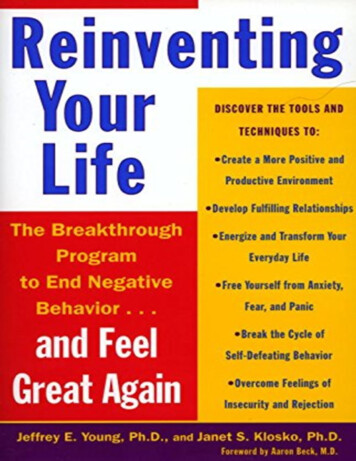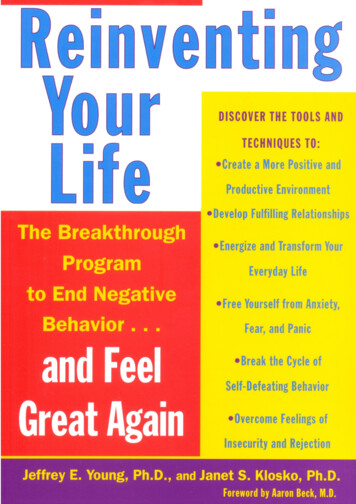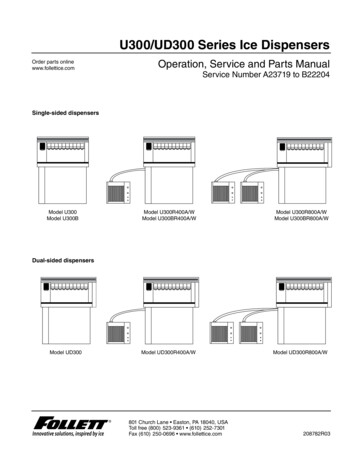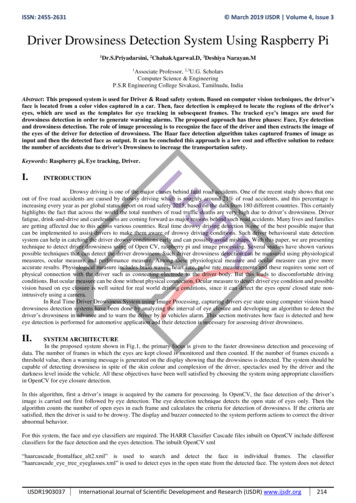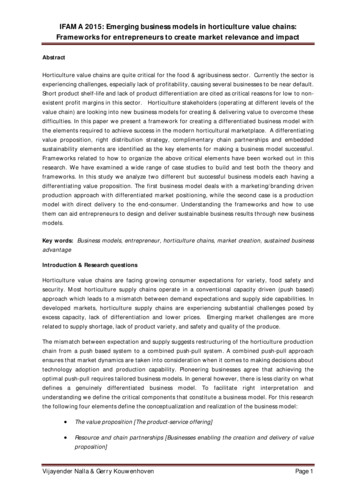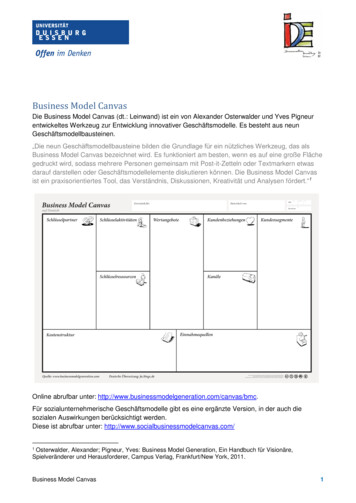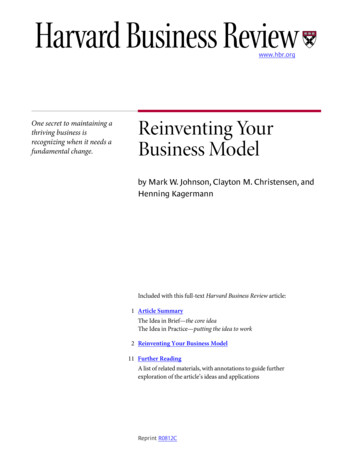
Transcription
www.hbr.orgOne secret to maintaining athriving business isrecognizing when it needs afundamental change.Reinventing YourBusiness Modelby Mark W. Johnson, Clayton M. Christensen, andHenning KagermannIncluded with this full-text Harvard Business Review article:1 Article SummaryThe Idea in Brief—the core ideaThe Idea in Practice—putting the idea to work2 Reinventing Your Business Model11 Further ReadingA list of related materials, with annotations to guide furtherexploration of the article’s ideas and applicationsReprint R0812C
Reinventing Your Business ModelThe Idea in BriefThe Idea in PracticeWhen Apple introduced the iPod, it didsomething far smarter than wrap a goodtechnology in a snazzy design. It wrapped agood technology in a great businessmodel. Combining hardware, software,and service, the model provided gamechanging convenience for consumersand record-breaking profits for Apple.UNDERSTAND YOUR CURRENT BUSINESSMODELGreat business models can reshape industries and drive spectacular growth.Yet many companies find business-modelinnovation difficult. Managers don’t understand their existing model well enough toknow when it needs changing—or how.To determine whether your firm shouldalter its business model, Johnson, Christensen, and Kagermann advise thesesteps:COPYRIGHT 2008 HARVARD BUSINESS SCHOOL PUBLISHING CORPORATION. ALL RIGHTS RESERVED.1. Articulate what makes your existingmodel successful. For example, what customer problem does it solve? How doesit make money for your firm?2. Watch for signals that your model needschanging, such as tough new competitorson the horizon.3. Decide whether reinventing yourmodel is worth the effort. The answer’s yesonly if the new model changes the industryor market.accepted lower-than-standard gross margins, and sold the Nano in large volumes toits target market: first-time car buyers inemerging markets.A successful model has these components: Customer value proposition. The modelhelps customers perform a specific “job”that alternative offerings don’t address.Example:MinuteClinics enable people to visit adoctor’s office without appointments bymaking nurse practitioners available totreat minor health issues. Key resources and processes. Your company has the people, technology, products,facilities, equipment, and brand requiredto deliver the value proposition to yourtargeted customers. And it has processes(training, manufacturing, service) to leverage those resources. Profit formula. The model generates valuefor your company through factors such asrevenue model, cost structure, margins, andinventory turnover.Example:The Tata Group’s inexpensive car, theNano, is profitable because the companyhas reduced many cost structure elements,Example:For Tata Motors to fulfill the requirementsof the Nano’s profit formula, it had to reconceive how a car is designed, manufactured,and distributed. It redefined its supplierstrategy, choosing to outsource a remarkable 85% of the Nano’s components and touse nearly 60% fewer vendors than normalto reduce transaction costs.IDENTIFY W HEN A NEW MODEL MAY BE NEEDEDThese circumstances often require business model change:An opportunity to . . .ExampleAddress needs of large groupswho find existing solutionstoo expensive or complicated.The Nano’s goal is to open car ownership to low-income consumersin emerging markets.Capitalize on new technology,or leverage existing technologies in new markets.A company develops a commercial application for a technologyoriginally developed for military use.Bring a job-to-be-done focuswhere it doesn’t exist.FedEx focused on performing customers’ unmet “job”: Receivepackages faster and more reliably than any other service could.A need to . . .ExampleFend off low-end disruptors.Mini-mills threatened the integrated steel mills a generation ago bymaking steel at significantly lower prices.Respond to shifts incompetition.Power-tool maker Hilti switched from selling to renting its tools inpart because “good enough” low-end entrants had begun chippingaway at the market for selling high-quality tools.page 1
One secret to maintaining a thriving business is recognizing when itneeds a fundamental change.Reinventing YourBusiness ModelCOPYRIGHT 2008 HARVARD BUSINESS SCHOOL PUBLISHING CORPORATION. ALL RIGHTS RESERVED.by Mark W. Johnson, Clayton M. Christensen, andHenning KagermannIn 2003, Apple introduced the iPod with theiTunes store, revolutionizing portable entertainment, creating a new market, and transforming the company. In just three years, theiPod/iTunes combination became a nearly 10 billion product, accounting for almost 50%of Apple’s revenue. Apple’s market capitalization catapulted from around 1 billion in early2003 to over 150 billion by late 2007.This success story is well known; what’s lesswell known is that Apple was not the first tobring digital music players to market. A company called Diamond Multimedia introducedthe Rio in 1998. Another firm, Best Data,introduced the Cabo 64 in 2000. Both products worked well and were portable andstylish. So why did the iPod, rather than theRio or Cabo, succeed?Apple did something far smarter than takea good technology and wrap it in a snazzydesign. It took a good technology andwrapped it in a great business model. Apple’strue innovation was to make downloadingdigital music easy and convenient. To doharvard business review december 2008that, the company built a groundbreakingbusiness model that combined hardware, software, and service. This approach worked likeGillette’s famous blades-and-razor model inreverse: Apple essentially gave away the“blades” (low-margin iTunes music) to lockin purchase of the “razor” (the high-marginiPod). That model defined value in a new wayand provided game-changing convenience tothe consumer.Business model innovations have reshapedentire industries and redistributed billions ofdollars of value. Retail discounters such as WalMart and Target, which entered the marketwith pioneering business models, now accountfor 75% of the total valuation of the retail sector. Low-cost U.S. airlines grew from a blip onthe radar screen to 55% of the market value ofall carriers. Fully 11 of the 27 companies born inthe last quarter century that grew their wayinto the Fortune 500 in the past 10 years didso through business model innovation.Stories of business model innovationfrom well-established companies like Apple,page 2
Reinventing Your Business ModelMark W. Johnson (mjohnson@innosight.com) is the chairman ofInnosight, an innovation and strategyconsulting firm he cofounded in2000 with Clayton M. Christensen(cchristensen@hbs.edu), the Robertand Jane Cizik Professor of BusinessAdministration at Harvard BusinessSchool. They are both based in Boston.Henning Kagermann (henning.kagermann@sap.com) is the co-CEOof SAP AG, in Walldorf, Germany.Johnson is the author of Seizing theWhite Space: Business Model Innovationfor Transformative Growth and Renewal,forthcoming from Harvard BusinessPress in 2009.however, are rare. An analysis of major innovations within existing corporations inthe past decade shows that precious few havebeen business-model related. And a recentAmerican Management Association studydetermined that no more than 10% of innovation investment at global companies isfocused on developing new business models.Yet everyone’s talking about it. A 2005survey by the Economist Intelligence Unitreported that over 50% of executives believebusiness model innovation will become evenmore important for success than product orservice innovation. A 2008 IBM survey ofcorporate CEOs echoed these results. Nearlyall of the CEOs polled reported the need toadapt their business models; more than twothirds said that extensive changes were required. And in these tough economic times,some CEOs are already looking to businessmodel innovation to address permanent shiftsin their market landscapes.Senior managers at incumbent companiesthus confront a frustrating question: Why is itso difficult to pull off the new growth thatbusiness model innovation can bring? Ourresearch suggests two problems. The first is alack of definition: Very little formal study hasbeen done into the dynamics and processesof business model development. Second, fewcompanies understand their existing businessmodel well enough—the premise behind itsdevelopment, its natural interdependencies,and its strengths and limitations. So theydon’t know when they can leverage their corebusiness and when success requires a newbusiness model.After tackling these problems with dozens ofcompanies, we have found that new businessmodels often look unattractive to internal andexternal stakeholders—at the outset. To seepast the borders of what is and into the landof the new, companies need a road map.Ours consists of three simple steps. The firstis to realize that success starts by not thinkingabout business models at all. It starts withthinking about the opportunity to satisfy areal customer who needs a job done. Thesecond step is to construct a blueprint layingout how your company will fulfill that needat a profit. In our model, that plan has fourelements. The third is to compare that modelto your existing model to see how much you’dhave to change it to capture the opportunity.harvard business review december 2008Once you do, you will know if you can useyour existing model and organization or needto separate out a new unit to execute a newmodel. Every successful company is alreadyfulfilling a real customer need with an effective business model, whether that model isexplicitly understood or not. Let’s take a lookat what that entails.Business Model: A DefinitionA business model, from our point of view,consists of four interlocking elements that,taken together, create and deliver value. Themost important to get right, by far, is the first.Customer value proposition (CVP). A successful company is one that has found a wayto create value for customers—that is, a way tohelp customers get an important job done. By“job” we mean a fundamental problem in agiven situation that needs a solution. Once weunderstand the job and all its dimensions,including the full process for how to get itdone, we can design the offering. The moreimportant the job is to the customer, thelower the level of customer satisfaction withcurrent options for getting the job done, andthe better your solution is than existing alternatives at getting the job done (and, of course,the lower the price), the greater the CVP.Opportunities for creating a CVP are at theirmost potent, we have found, when alternativeproducts and services have not been designedwith the real job in mind and you can designan offering that gets that job—and onlythat job—done perfectly. We’ll come back tothat point later.Profit formula. The profit formula is theblueprint that defines how the companycreates value for itself while providing valueto the customer. It consists of the following: Revenue model: price x volume Cost structure: direct costs, indirect costs,economies of scale. Cost structure will bepredominantly driven by the cost of the keyresources required by the business model. Margin model: given the expected volumeand cost structure, the contribution neededfrom each transaction to achieve desiredprofits. Resource velocity: how fast we need toturn over inventory, fixed assets, and otherassets—and, overall, how well we need toutilize resources—to support our expectedvolume and achieve our anticipated profits.page 3
Reinventing Your Business ModelPeople often think the terms “profit formulas” and “business models” are interchangeable. But how you make a profit is only onepiece of the model. We’ve found it most useful to start by setting the price required todeliver the CVP and then work backwardsfrom there to determine what the variablecosts and gross margins must be. This then determines what the scale and resource velocityneeds to be to achieve the desired profits.Key resources. The key resources are assetssuch as the people, technology, products,facilities, equipment, channels, and brandrequired to deliver the value proposition tothe targeted customer. The focus here is onthe key elements that create value for thecustomer and the company, and the way thoseelements interact. (Every company also hasgeneric resources that do not create competitive differentiation.)Key processes. Successful companies haveoperational and managerial processes thatallow them to deliver value in a way theycan successfully repeat and increase in scale.These may include such recurrent tasks astraining, development, manufacturing, budgeting, planning, sales, and service. Keyprocesses also include a company’s rules,metrics, and norms.These four elements form the buildingblocks of any business. The customer valueproposition and the profit formula definevalue for the customer and the company,respectively; key resources and key processesdescribe how that value will be delivered toboth the customer and the company.As simple as this framework may seem, itspower lies in the complex interdependenciesof its parts. Major changes to any of thesefour elements affect the others and thewhole. Successful businesses devise a moreor less stable system in which these elementsbond to one another in consistent and complementary ways.How Great Models Are BuiltTo illustrate the elements of our businessmodel framework, we will look at what’s behind two companies’ game-changing businessmodel innovations.Creating a customer value proposition.It’s not possible to invent or reinvent a business model without first identifying a clearcustomer value proposition. Often, it startsharvard business review december 2008as a quite simple realization. Imagine, for amoment, that you are standing on a Mumbairoad on a rainy day. You notice the largenumber of motor scooters snaking precariously in and out around the cars. As you lookmore closely, you see that most bear wholefamilies—both parents and several children.Your first thought might be “That’s crazy!” or“That’s the way it is in developing countries—people get by as best they can.”When Ratan Tata of Tata Group lookedout over this scene, he saw a critical job to bedone: providing a safer alternative for scooterfamilies. He understood that the cheapest caravailable in India cost easily five times what ascooter did and that many of these familiescould not afford one. Offering an affordable,safer, all-weather alternative for scooter families was a powerful value proposition, onewith the potential to reach tens of millionsof people who were not yet part of thecar-buying market. Ratan Tata also recognizedthat Tata Motors’ business model could notbe used to develop such a product at theneeded price point.At the other end of the market spectrum,Hilti, a Liechtenstein-based manufacturer ofhigh-end power tools for the construction industry, reconsidered the real job to be donefor many of its current customers. A contractor makes money by finishing projects; if therequired tools aren’t available and functioning properly, the job doesn’t get done. Contractors don’t make money by owning tools;they make it by using them as efficientlyas possible. Hilti could help contractors getthe job done by selling tool use instead of thetools themselves—managing its customers’tool inventory by providing the best tool atthe right time and quickly furnishing toolrepairs, replacements, and upgrades, all for amonthly fee. To deliver on that value proposition, the company needed to create a fleetmanagement program for tools and in theprocess shift its focus from manufacturingand distribution to service. That meant Hiltihad to construct a new profit formula anddevelop new resources and new processes.The most important attribute of a customervalue proposition is its precision: how perfectly it nails the customer job to be done—and nothing else. But such precision is oftenthe most difficult thing to achieve. Companiestrying to create the new often neglect to focuspage 4
Reinventing Your Business ModelThe Elements of a Successful Business ModelEvery successful company already operates according to an effective business model. By systematically identifying all of itsconstituent parts, executives can understand how the model fulfills a potent value proposition in a profitable way using certainkey resources and key processes. With that understanding, they can then judge how well the same model could be used to fulfilla radically different CVP—and what they’d need to do to construct a new one, if need be, to capitalize on that opportunity.Customer Value Proposition (CVP) Target customer Job to be done to solve animportant problem or fulfill animportant need for the targetcustomer Offering, which satisfies theproblem or fulfills the need.This is defined not only by whatis sold but also by how it’s sold.PROFIT FORMULAKEY RESOURCESneeded to deliver thecustomer value propositionprofitably. Might include: People Technology, products Equipment Information Channels Partnerships,alliances Brandharvard business review december 2008 Revenue model How muchmoney can be made: price xvolume. Volume can be thought ofin terms of market size, purchasefrequency, ancillary sales, etc. Cost structure How costs areallocated: includes cost of keyassets, direct costs, indirect costs,economies of scale. Margin model How much eachtransaction should net to achievedesired profit levels. Resource velocity How quicklyresources need to be used to support target volume. Includes leadtimes, throughput, inventory turns,asset utilization, and so on.KEY PROCESSES, as well asrules, metrics, and norms, thatmake the profitable delivery of thecustomer value proposition repeatable and scalable. Might include: Processes: design, productdevelopment, sourcing, manufacturing, marketing, hiring andtraining, IT Rules and metrics: margin requirements for investment, creditterms, lead times, supplier terms Norms: opportunity size neededfor investment, approach tocustomers and channelspage 5
Reinventing Your Business Modelon one job; they dilute their efforts by attempting to do lots of things. In doing lotsof things, they do nothing really well.One way to generate a precise customervalue proposition is to think about the fourmost common barriers keeping people fromgetting particular jobs done: insufficientwealth, access, skill, or time. Software makerIntuit devised QuickBooks to fulfill smallbusiness owners’ need to avoid running out ofcash. By fulfilling that job with greatly simplified accounting software, Intuit broke the skillsbarrier that kept untrained small-businessowners from using more-complicated accounting packages. MinuteClinic, the drugstorebased basic health care provider, broke thetime barrier that kept people from visitinga doctor’s office with minor health issues bymaking nurse practitioners available withoutappointments.Designing a profit formula. Ratan Tataknew the only way to get families off theirscooters and into cars would be to breakthe wealth barrier by drastically decreasingthe price of the car. “What if I can change thegame and make a car for one lakh?” Tatawondered, envisioning a price point of aroundUS 2,500, less than half the price of theHilti Sidesteps CommoditizationHilti is capitalizing on a game-changing opportunity to increase profitability byturning products into a service. Rather than sell tools (at lower and lower prices),it’s selling a “just-the-tool-you-need-when-you-need-it, no-repair-or-storage-hassles”service. Such a radical change in customer value proposition required a shift in allparts of its business model.TraditionalPower Tool CompanySales of industrial andprofessional power tools andaccessoriesHilti’s Tool FleetManagement ServiceCustomervaluepropositionLeasing a comprehensivefleet of tools to increase contractors’ on-site productivityLow margins,high inventory turnoverProfit formulaHigher margins; asset heavy;monthly payments for toolmaintenance, repair, andreplacementDistribution channel, low-costmanufacturing plants in developing countries, R&DKey resourcesand processesStrong direct-sales approach,contract management, IT systems for inventory management and repair, warehousingharvard business review december 2008cheapest car available. This, of course, haddramatic ramifications for the profit formula:It required both a significant drop in grossmargins and a radical reduction in manyelements of the cost structure. He knew,however, he could still make money if hecould increase sales volume dramatically,and he knew that his target base of consumerswas potentially huge.For Hilti, moving to a contract managementprogram required shifting assets from customers’ balance sheets to its own and generatingrevenue through a lease/subscription model.For a monthly fee, customers could have a fullcomplement of tools at their fingertips, withrepair and maintenance included. This wouldrequire a fundamental shift in all major components of the profit formula: the revenuestream (pricing, the staging of payments, andhow to think about volume), the cost structure(including added sales development and contract management costs), and the supportingmargins and transaction velocity.Identifying key resources and processes.Having articulated the value proposition forboth the customer and the business, companies must then consider the key resources andprocesses needed to deliver that value. For aprofessional services firm, for example, the keyresources are generally its people, and thekey processes are naturally people related(training and development, for instance). For apackaged goods company, strong brands andwell-selected channel retailers might be thekey resources, and associated brand-buildingand channel-management processes amongthe critical processes.Oftentimes, it’s not the individual resourcesand processes that make the difference buttheir relationship to one another. Companieswill almost always need to integrate theirkey resources and processes in a unique wayto get a job done perfectly for a set of customers. When they do, they almost always createenduring competitive advantage. Focusingfirst on the value proposition and the profitformula makes clear how those resources andprocesses need to interrelate. For example,most general hospitals offer a value proposition that might be described as, “We’ll doanything for anybody.” Being all things toall people requires these hospitals to havea vast collection of resources (specialists,equipment, and so on) that can’t be knitpage 6
Reinventing Your Business Modeltogether in any proprietary way. The resultis not just a lack of differentiation but dissatisfaction.By contrast, a hospital that focuses on aspecific value proposition can integrate itsresources and processes in a unique way thatdelights customers. National Jewish Healthin Denver, for example, is organized around afocused value proposition we’d characterizeas, “If you have a disease of the pulmonarysystem, bring it here. We’ll define its rootcause and prescribe an effective therapy.”Narrowing its focus has allowed NationalJewish to develop processes that integrate theways in which its specialists and specializedequipment work together.For Tata Motors to fulfill the requirementsof its customer value proposition and profitformula for the Nano, it had to reconceivehow a car is designed, manufactured, anddistributed. Tata built a small team of fairlyyoung engineers who would not, like thecompany’s more-experienced designers, beinfluenced and constrained in their thinkingby the automaker’s existing profit formulas.This team dramatically minimized the number of parts in the vehicle, resulting in a significant cost saving. Tata also reconceived itssupplier strategy, choosing to outsource a remarkable 85% of the Nano’s components anduse nearly 60% fewer vendors than normal toreduce transaction costs and achieve bettereconomies of scale.At the other end of the manufacturingline, Tata is envisioning an entirely new wayof assembling and distributing its cars. Theultimate plan is to ship the modular components of the vehicles to a combined network of company-owned and independententrepreneur-owned assembly plants, whichwill build them to order. The Nano will bedesigned, built, distributed, and serviced in aradically new way—one that could not beaccomplished without a new business model.And while the jury is still out, Ratan Tata maysolve a traffic safety problem in the process.For Hilti, the greatest challenge lay in training its sales representatives to do a thoroughlynew task. Fleet management is not a halfhour sale; it takes days, weeks, even months ofmeetings to persuade customers to buy a program instead of a product. Suddenly, field repsaccustomed to dealing with crew leaders andon-site purchasing managers in mobile trailersharvard business review december 2008found themselves staring down CEOs andCFOs across conference tables.Additionally, leasing required new resources—new people, more robust IT systems, and other new technologies—to designand develop the appropriate packages andthen come to an agreement on monthlypayments. Hilti needed a process for maintaining large arsenals of tools more inexpensively and effectively than its customershad. This required warehousing, an inventory management system, and a supply ofreplacement tools. On the customer management side, Hilti developed a website thatenabled construction managers to view all thetools in their fleet and their usage rates. Withthat information readily available, the managers could easily handle the cost accountingassociated with those assets.Rules, norms, and metrics are often the lastelement to emerge in a developing businessmodel. They may not be fully envisioneduntil the new product or service has beenroad tested. Nor should they be. Businessmodels need to have the flexibility to changein their early years.When a New Business Model IsNeededEstablished companies should not undertakebusiness-model innovation lightly. Theycan often create new products that disruptcompetitors without fundamentally changingtheir own business model. Procter & Gamble,for example, developed a number of whatit calls “disruptive market innovations” withsuch products as the Swiffer disposable mopand duster and Febreze, a new kind of airfreshener. Both innovations built on P&G’sexisting business model and its establisheddominance in household consumables.There are clearly times, however, when creating new growth requires venturing not onlyinto unknown market territory but also intounknown business model territory. When? Theshort answer is “When significant changes areneeded to all four elements of your existingmodel.” But it’s not always that simple. Management judgment is clearly required. Thatsaid, we have observed five strategic circumstances that often require business modelchange:1. The opportunity to address through disruptive innovation the needs of large groupspage 7
Reinventing Your Business Modelof potential customers who are shut out of amarket entirely because existing solutionsare too expensive or complicated for them.This includes the opportunity to democratizeproducts in emerging markets (or reach thebottom of the pyramid), as Tata’s Nano does.2. The opportunity to capitalize on a brandnew technology by wrapping a new businessmodel around it (Apple and MP3 players)or the opportunity to leverage a tested technology by bringing it to a whole new market(say, by offering military technologies in thecommercial space or vice versa).3. The opportunity to bring a job-to-bedone focus where one does not yet exist.That’s common in industries where companies focus on products or customer segments,which leads them to refine existing productsmore and more, increasing commoditizationover time. A jobs focus allows companies toredefine industry profitability. For example,when FedEx entered the package deliverymarket, it did not try to compete throughlower prices or better marketing. Instead, itconcentrated on fulfilling an entirely unmetcustomer need to receive packages far, farfaster, and more reliably, than any servicethen could. To do so, it had to integrate itskey processes and resources in a vastly moreefficient way. The business model that resulted from this job-to-be-done emphasisDow Corning Embraces the Low EndTraditionally high-margin Dow Corning found new opportunities in low-marginofferings by setting up a separate business unit that operates in an entirely differentway. By fundamentally differentiating its low-end and high-end offerings, the company avoided cannibalizing its traditional business even as it found new profits atthe low end.Established BusinessCustomized solutions,negotiated contractsNew Business UnitCustomer valuepropositionNo frills, bulk prices,sold through the internetHigh-margin, highoverhead retail prices payfor value-added servicesProfit formulaSpot-market pricing, lowoverhead to accommodate lower margins, highthroughputR&D, sales, and serviceorientationKey resourcesand processesharvard business review december 2008IT system, lowest-costprocesses, maximumautomationgave FedEx a significant competitive advantage that took UPS many years to copy.4. The need to fend off low-end disrupters.If the Nano is successful, it will threatenother automobile makers, much as minimillsthreatened the integrated steel mills a generation ago by making steel at significantlylower cost.5. The need to respond to a shifting basisof competition. Inevitably, what defines anacceptable solution in a market will changeover time, leading core market segments tocommoditize. Hilti needed to change its business model in part because of lower globalmanufacturing costs; “good enough” low-endentrants had begun chipping away at themarket for high-quality power tools.Of course, companies should not pursuebusiness model reinvention unless they areconfident that the opportunity is large enoughto warrant the effort. And, there’s really nopoint in instituting a new business modelunless it’s not only new to the company butin some way new or game-changing to t
Reinventing Your Business Model harvard business review december 2008 page 3 however, are rare. An analysis of major in-novations within existing corporations in the past decade shows that precious few have been business-model related. And a recent American Management Association study determined that no more than 10% of inno-
